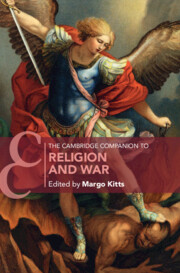Book contents
- The Cambridge Companion to Religion and War
- Cambridge Companions to Religion
- The Cambridge Companion to Religion and War
- Copyright page
- Contents
- Contributors
- Preface
- Introduction
- Part I Classical Foundations
- Part II Just War
- Part III Religious Nationalism
- Part IV Featured Conflicts
- 19 Christian Crusading, Ritual, and Liturgy
- 20 A Paradigm of Pious Jihād in the Muslim Ethos
- 21 Fierce Goddesses of India
- 22 The Demonological Framework of the Heavenly Kingdom of Great Peace
- 23 War Outside the State
- Index
- Cambridge Companions to Religion (continued from page ii)
- References
23 - War Outside the State
Religious Communities, Martiality, and State Formation in Early Modern South Asia
from Part IV - Featured Conflicts
Published online by Cambridge University Press: 04 May 2023
- The Cambridge Companion to Religion and War
- Cambridge Companions to Religion
- The Cambridge Companion to Religion and War
- Copyright page
- Contents
- Contributors
- Preface
- Introduction
- Part I Classical Foundations
- Part II Just War
- Part III Religious Nationalism
- Part IV Featured Conflicts
- 19 Christian Crusading, Ritual, and Liturgy
- 20 A Paradigm of Pious Jihād in the Muslim Ethos
- 21 Fierce Goddesses of India
- 22 The Demonological Framework of the Heavenly Kingdom of Great Peace
- 23 War Outside the State
- Index
- Cambridge Companions to Religion (continued from page ii)
- References
Summary
This chapter explores the role of early modern non-state actors in organized martial conflicts to understand how diverse social formations define “war” prior to the institution of the nation-state system. Exploration of how such actors interacted with states, and often operated independently of them, enhances our understanding of the multiple locations of organized violence without the assumption of state formation as a goal and allows greater appreciation of the sometimes dispersed nature of martial coercion.
- Type
- Chapter
- Information
- The Cambridge Companion to Religion and War , pp. 443 - 462Publisher: Cambridge University PressPrint publication year: 2023



